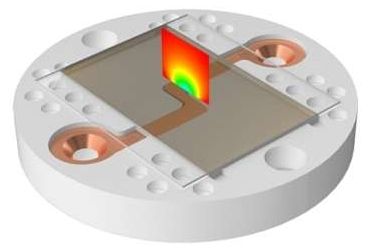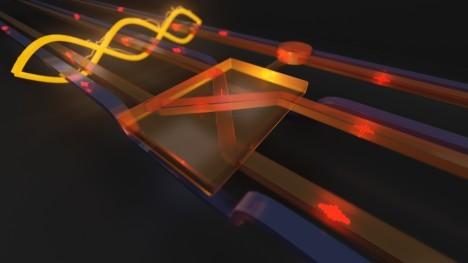Archive for the ‘quantum physics’ category: Page 818
Apr 2, 2016
All quantum communication involves nonlocality
Posted by Andreas Matt in categories: computing, particle physics, quantum physics
Researchers of CWI, University of Gdansk, Gdansk University of Technology, Adam Mickiewicz University and the University of Cambridge have proven that quantum communication is based on nonlocality. They show that whenever quantum communication is more efficient than classical communication, it must be possible find a nonlocal correlation somewhere. Their paper ‘Quantum communication complexity advantage implies violation of a Bell inequality’, appeared in this month’s issue of the influential journal PNAS.
It has long been known that quantum mechanics predicts counterintuitive effects such as instantaneous interaction at a distance between entangled particles. This teleportation effect, which Albert Einstein famously called ‘spooky action at a distance,’ was long thought to show that the theory of quantum mechanics was incomplete. However, in 1964, physicist J.S. Bell proved that no theory involving the principle of locality can ever reproduce all predictions of quantum mechanics. In other words, it is impossible to find classical explanations for quantum correlations. This evidence for the existence of nonlocality became known as Bell’s inequality.
For a long time, the existence of quantum correlations was merely of interest to philosophically minded physicists, and was considered an exotic peculiarity rather than a useful resource for practical problems in physics or computer science. This has changed dramatically in recent years. Quantum correlation proved to be very useful in information processing. In several communication tasks, using quantum effects substantially reduced the communication complexity: the minimum number of steps necessary to complete a certain task between two parties. In such cases, there is a so-called quantum advantage in communication complexity.
Mar 31, 2016
Is the black hole at our galaxy’s centre a quantum computer? – Sabine Hossenfelder Essays
Posted by Andreas Matt in categories: computing, cosmology, quantum physics
Black-hole computing.
Might nature’s bottomless pits actually be ultra-efficient quantum computers? That could explain why data never dies.
Mar 30, 2016
Second quantum revolution a reality with chip-based atomic physics
Posted by Klaus Baldauf in categories: computing, engineering, particle physics, quantum physics
A University of Oklahoma-led team of physicists believes chip-based atomic physics holds promise to make the second quantum revolution—the engineering of quantum matter with arbitrary precision—a reality. With recent technological advances in fabrication and trapping, hybrid quantum systems are emerging as ideal platforms for a diverse range of studies in quantum control, quantum simulation and computing.
James P. Shaffer, professor in the Homer L. Dodge Department of Physics and Astronomy, OU College of Arts and Sciences; Jon Sedlacek, OU graduate student; and a team from the University of Nevada, Western Washington University, The United States Naval Academy, Sandia National Laboratories and Harvard-Smithsonian Center for Astrophysics, have published research important for integrating Rydberg atoms into hybrid quantum systems and the fundamental study of atom–surface interactions, as well as applications for electrons bound to a 2D surface.
“A convenient surface for application in hybrid quantum systems is quartz because of its extensive use in the semiconductor and optics industries,” Sedlacek said. “The surface has been the subject of recent interest as a result of it stability and low surface energy. Mitigating electric fields near ‘trapping’ surfaces is the holy grail for realizing hybrid quantum systems,” added Hossein Sadeghpour, director of the Institute for Theoretical Atomic Molecular and Optical Physics, Harvard-Smithsonian Center for Astrophysics.
Continue reading “Second quantum revolution a reality with chip-based atomic physics” »
Mar 30, 2016
Quantum computing with single photons getting closer to reality
Posted by Andreas Matt in categories: computing, quantum physics
(Phys.org)—One promising approach for scalable quantum computing is to use an all-optical architecture, in which the qubits are represented by photons and manipulated by mirrors and beam splitters. So far, researchers have demonstrated this method, called Linear Optical Quantum Computing, on a very small scale by performing operations using just a few photons. In an attempt to scale up this method to larger numbers of photons, researchers in a new study have developed a way to fully integrate single-photon sources inside optical circuits, creating integrated quantum circuits that may allow for scalable optical quantum computation.
The researchers, Iman Esmaeil Zadeh, Ali W. Elshaari, and coauthors, have published a paper on the integrated quantum circuits in a recent issue of Nano Letters.
As the researchers explain, one of the biggest challenges facing the realization of an efficient Linear Optical Quantum Computing system is integrating several components that are usually incompatible with each other onto a single platform. These components include a single-photon source such as quantum dots; routing devices such as waveguides; devices for manipulating photons such as cavities, filters, and quantum gates; and single-photon detectors.
Mar 30, 2016
New Video: The Physics of Quantum Annealing
Posted by Klaus Baldauf in category: quantum physics

In our last video we explained quantum annealing, and how the D-Wave system uses it for computation. In this new video we drill down into the physics of quantum annealing, and explain the concepts of the Hamiltonian and Eigenspectrum.
Mar 29, 2016
Twisting puts the brakes on light in a vacuum
Posted by Andreas Matt in categories: computing, quantum physics
A team of researchers at the University of Ottawa has discovered that twisted light moves slower than the speed of light in a vacuum set by Einstein’s theory of relativity, with major implications for the development of quantum computing and communications.
Mar 28, 2016
Quantum Computers Move Closer To Reality With ‘Fredkin Gate’ Breakthrough
Posted by Aleksandar Vukovic in categories: computing, quantum physics
The development of the logic gate had long been a stumbling block in the creation of functional quantum computers.
Mar 28, 2016
The Quantum Fluid Inside Neutron Stars
Posted by Andreas Matt in category: quantum physics

In 1937 Pyotr Kapitsa and John F. Allen discovered a strange behavior of ultracold liquids known as superfluidity. A superfluid is a fluid with no viscosity, basically a frictionless liquid. Without viscosity, the fluid has no way to dampen its motion. Because of this, superfluids have some pretty unusual behaviors. If a bit of superfluid is suspended in an open container, it will creep up along the walls, then drip down to a lower container. It can flow through tiny pores that regular liquids can’t, and can create fountains that could flow forever. This seeming defiance of gravity and common sense is due to the fact that its behavior is rooted in quantum physics. Though it is not a truly quantum state such as a Bose-Einstein condensate, it shares some commonality with it. In the lab, superfluids are only seen at temperatures barely above absolute zero. The most common example, helium-4, becomes superfluid when cooled below 2.17 K. So it might seem odd that superfluids are also found in the hot interiors of neutron stars.
A neutron star is a stellar remnant formed with a star runs out of hydrogen and heavier elements to fuse. After a star explodes as a supernova, the remaining core of the star collapses under its own weight to the point that only the pressure of nuclei can counter the force of gravity. A neutron star has a mass of about two Suns, but are only about 20 kilometers in diameter. They have a dense atmosphere of carbon only a few centimeters thick, and a thin crust of iron nuclei. In the interior of a neutron star, nuclei are pushed together ever more tightly, and reach a point where the nuclei can’t hold themselves together. As a result, individual neutrons “drip” out, and sink into the star’s core, forming a neutron fluid. As a neutron star cools, this neutron fluid transitions to a superfluid state. This happens not at a few degrees Kelvin, but at 500 to 800 million Kelvin. The interior of a neutron star is a hot superfluid sea.
Mar 26, 2016
Google’s Quantum Dream Machine
Posted by Klaus Baldauf in categories: computing, quantum physics
Physicist John Martinis could deliver one of the holy grails of computing to Google—a machine that dramatically speeds up today’s applications and makes new ones possible.
















